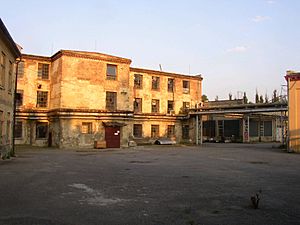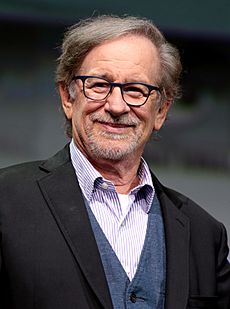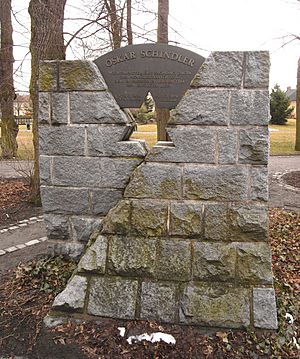Oskar Schindler facts for kids
Quick facts for kids
Oskar Schindler
|
|
|---|---|
 |
|
| Born | 28 April 1908 |
| Died | 9 October 1974 (aged 66) |
| Resting place | Mount Zion Catholic Cemetery Jerusalem, Israel |
| Occupation | Industrialist |
| Political party |
|
| Spouse(s) |
Emilie Pelzl
(m. 1928) |
| Children | 2 |
| Awards | Righteous Among the Nations |
Oskar Schindler (28 April 1908 – 9 October 1974) was a German businessman and a member of the Nazi Party. He is famous for saving the lives of about 1,200 Jewish people during the Holocaust. He did this by employing them in his factories in occupied Poland and the Protectorate of Bohemia and Moravia.
Schindler's story was told in the 1982 book Schindler's Ark and the 1993 movie Schindler's List. These stories show how he started out wanting to make money, but then bravely worked to save his Jewish employees.
Schindler grew up in Zwittau, which is now in the Czech Republic. He worked in different jobs before joining the Abwehr in 1936. This was the military intelligence service of Nazi Germany. He joined the Nazi Party in 1939. Before Germany took over Czechoslovakia in 1938, he gathered information for the German government. He was arrested for spying but was released. He continued to spy in Poland before World War II began in 1939.
In 1939, he bought an enamelware factory in Kraków, Poland. At its busiest in 1944, it had about 1,750 workers, with 1,000 of them being Jewish. His connections helped him protect his Jewish workers from being sent to Nazi concentration camps. Over time, he had to give Nazi officials more and more bribes to keep his workers safe.
By July 1944, Germany was losing the war. The SS began closing down concentration camps and moving prisoners. Many were killed in Auschwitz. Schindler convinced SS officer Amon Göth to let him move his factory to Brněnec in the Czech Republic. This saved his workers from almost certain death. A list of 1,200 Jews was made to travel to Brünnlitz in October 1944. Schindler kept bribing SS officials to protect his workers until the war ended in May 1945. By then, he had spent all his money on bribes and supplies for his workers.
After the war, Schindler moved to West Germany. He received help from Jewish relief groups. He later moved to Argentina with his wife, Emilie, to try farming. When his business failed in 1958, Schindler returned to Germany. He struggled with other businesses and relied on financial help from the Schindlerjuden (Schindler Jews). These were the people he had saved during the war. He died on 9 October 1974 in Hildesheim, Germany. He was buried in Jerusalem on Mount Zion. He is the only former Nazi Party member to be honored this way. In 1993, he and his wife Emilie were named Righteous Among the Nations by the Israeli government.
Contents
Early Life and Beginnings
Oskar Schindler was born on 28 April 1908, in Zwittau, which was then part of Austria-Hungary. His father, Johann Schindler, owned a farm machinery business. His mother was Franziska Schindler. He had one sister, Elfriede. After finishing school, Schindler took courses in different trades. For a few years, he enjoyed racing motorcycles.
On 6 March 1928, Schindler married Emilie Pelzl. She was the daughter of a successful farmer. They lived with Oskar's parents for seven years. Schindler worked various jobs, including at an electrical company and managing a driving school. After serving in the Czech army, he returned to the electrical company, which soon went out of business. His father's business also closed. For a year, Schindler was unemployed. He then worked at a bank in Prague until 1938.
Becoming a Spy
In 1935, Schindler joined the Sudeten German Party. In 1936, he became a spy for the Abwehr, the military intelligence service of Nazi Germany. He later said he did it because he needed money. He was often in debt.
His job was to gather information on railways and troop movements in Czechoslovakia. He also recruited other spies. He was arrested for spying in July 1938. However, he was released under the Munich Agreement. This agreement allowed Germany to take over the Czech Sudetenland. Schindler joined the Nazi Party in November 1938.
In January 1939, Schindler moved to Ostrava with his wife. He continued spying before Hitler took over the rest of Czechoslovakia in March. Emilie helped him by handling and hiding secret documents. Schindler often traveled to Poland for business. He and his agents gathered information about Polish military activities and railways. This was for the planned invasion of Poland. Schindler continued working for the Abwehr until late 1940.
World War II and Saving Lives
The Emalia Factory
Schindler arrived in Kraków in October 1939. He soon met Poldek Pfefferberg, who became a contact for getting goods on the black market. They became lifelong friends.
In November 1939, Schindler learned about an enamelware factory that was bankrupt. It was owned by Jewish businessmen. He was advised to buy or lease the business. This would give him more freedom from Nazi rules, including the freedom to hire more Jewish workers.
With money from Jewish investors, Schindler leased the factory in January 1940. He renamed it Deutsche Emailwarenfabrik (German Enamelware Factory), or DEF. It was also known as "Emalia." He started with seven Jewish workers and 250 non-Jewish Poles. By 1944, the factory employed about 1,750 workers, with 1,000 of them being Jewish.
Schindler's connections with the Abwehr and the German army helped him get contracts. He produced enamel cookware for the military. These connections also helped him protect his Jewish workers. To keep them safe, Schindler had to give Nazi officials more and more bribes. These bribes included expensive items from the black market.
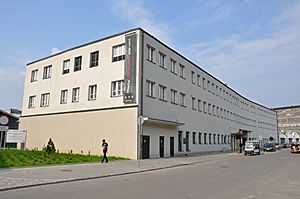
At first, Schindler was mainly interested in making money. He hired Jewish workers because they were cheaper. But later, he began to protect his workers, no matter the cost. His factory was important for the war effort. This helped him protect his Jewish workers. Whenever his Schindlerjuden (Schindler Jews) were threatened, he claimed they were essential workers. He even claimed wives, children, and people with disabilities were needed for the factory.
In August 1940, all Jews in Kraków were ordered to leave the city. Only those with jobs important to the German war effort could stay. By March 1941, only 15,000 Jews remained. They were forced to move into the Kraków Ghetto. Schindler's workers walked to and from the ghetto each day. Schindler expanded the factory to include a clinic, kitchen, and dining room for his workers.
Life in Płaszów
In fall 1941, the Nazis began sending Jews out of the ghetto. Most were sent to death camps. On 13 March 1943, the ghetto was emptied. Those able to work were sent to the new concentration camp at Płaszów. Thousands not fit for work were murdered. Schindler knew about these plans through his contacts. He had his workers stay at the factory overnight to keep them safe. Schindler saw the terrible events of the ghetto's emptying. From that moment, he decided to save as many Jews as he could.
The Kraków-Płaszów concentration camp opened in March 1943. The camp commander was SS-Hauptsturmführer Amon Göth. Prisoners in Płaszów lived in constant fear. Emilie Schindler called Göth "the most despicable man I have ever met."
Göth wanted to move all factories, including Schindler's, inside the camp. But Schindler used diplomacy, flattery, and bribes to prevent this. He even convinced Göth to let him build a subcamp at Emalia. This camp housed his workers and 450 other Jews. There, they were safe from random killings, well-fed, and allowed to practice their religion.
Schindler was arrested three times. Twice for black market activities and once for kissing a Jewish girl. This was against the Nuremberg Laws. His influential contacts in the Nazi Party helped him get released each time. In October 1944, he was arrested again. He was accused of black marketeering and bribing Göth to improve worker conditions. He was held for about a week and then released.
In 1943, Schindler secretly met with Jewish resistance leaders. He traveled to Budapest several times to report on how the Nazis were treating Jews. He brought back money from the Jewish Agency for Israel to help the Jewish underground.
Moving to Brünnlitz
As the Red Army got closer in July 1944, the SS began closing eastern concentration camps. Prisoners were moved west to Auschwitz and Gross-Rosen concentration camp. Göth's secretary, Mietek Pemper, told Schindler about the Nazis' plans to close factories. Pemper suggested Schindler switch from making cookware to anti-tank grenades. This would help save the Jewish workers.
Schindler used bribes and his powers of persuasion. He convinced Göth and officials in Berlin to let him move his factory and workers to Brünnlitz in the Sudetenland. This saved them from certain death in the gas chambers. A list of 1,200 Jews was made. This included 1,000 of Schindler's workers and 200 from another factory. They were sent to Brünnlitz in October 1944.
A train carrying 700 men from Schindler's list was first sent to Gross-Rosen concentration camp. They spent about a week there before being rerouted to Brünnlitz. Three hundred Jewish women from Schindler's list were sent to Auschwitz. They were in great danger of being sent to the gas chambers. Schindler's usual bribes did not work at first. Finally, his secretary, Hilde Albrecht, brought more bribes. These included black market goods, food, and diamonds. The women were then sent to Brünnlitz after several terrifying weeks in Auschwitz.
Schindler moved 250 wagon loads of machinery and materials to the new factory. The factory produced very few useful artillery shells. When officials questioned the low output, Schindler bought finished goods on the black market. He then resold them as his own. The food provided by the SS was not enough for the workers. So, Schindler spent most of his time in Kraków getting food and other supplies. His wife Emilie stayed in Brünnlitz. She secretly got more food and cared for the workers' health. Schindler also arranged for up to 3,000 Jewish women to be moved from Auschwitz to small textile plants. This increased their chances of surviving the war.
In January 1945, a train with 250 Jewish people arrived at Brünnlitz. They had been rejected as workers at a German mine. The train cars were frozen shut. Emilie Schindler waited while an engineer opened the cars. Twelve people were dead. The rest were too sick to work. Emilie took the survivors into the factory. She cared for them in a makeshift hospital until the war ended. Schindler continued to bribe SS officials to prevent his workers from being killed. On 7 May 1945, he and his workers listened to British Prime Minister Winston Churchill announce that Germany had surrendered. The war in Europe was over.
After the War and Legacy
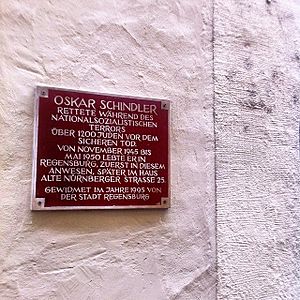
As a member of the Nazi Party and the Abwehr, Schindler was in danger of being arrested as a war criminal. His Jewish friends prepared a statement for him. It explained his role in saving Jewish lives. He was also given a ring made from gold teeth. The ring was engraved with "Whoever saves one life saves the world entire." To escape the Soviets, Schindler and his wife traveled west. They eventually reached American lines and then went to Switzerland. They moved to Bavaria in Germany in late 1945.

By the end of the war, Schindler had spent all his money. He was almost poor. He received help from Jewish organizations. In 1948, he asked for money back for his wartime expenses. He received $15,000. He estimated his total spending was over $1 million. This included costs for building the camp, bribes, and black market goods like food.
In 1949, Schindler moved to Argentina. He tried raising chickens and then small animals for fur. When his business failed in 1958, he left his wife and returned to Germany. He had several unsuccessful business ventures. He declared bankruptcy in 1963 and had a heart attack in 1964. He stayed in touch with many of the Jews he saved. He lived on donations from Schindlerjuden around the world.
Schindler died on 9 October 1974. He is buried in Jerusalem on Mount Zion. He is the only Nazi Party member to be honored with a burial there.
For his actions during the war, Yad Vashem honored Schindler on 8 May 1962. A tree was planted in his honor in the Garden of the Righteous Among the Nations. He and his wife Emilie were named Righteous Among the Nations on 24 June 1993. This award is given by Israel to non-Jews who helped rescue Jews during the Holocaust. Schindler also received other awards, like the German Order of Merit in 1966.
Writer Herbert Steinhouse interviewed Schindler in 1948. He wrote that Schindler's actions came from a basic sense of decency. Schindler himself said, "I felt that the Jews were being destroyed. I had to help them; there was no choice."
Schindler's Story in Film and Books
In 1951, Poldek Pfefferberg asked director Fritz Lang to make a film about Schindler. Later, in 1964, Schindler received $20,000 for a film idea called To the Last Hour. But neither film was made. Schindler quickly spent the money.
In 1980, Australian author Thomas Keneally met Pfefferberg by chance. Pfefferberg told him Oskar Schindler's story. Keneally decided to write a fictionalized version of the story. After much research and interviews with surviving Schindlerjuden, he wrote Schindler's Ark. It was published in 1982. In the United States, it was called Schindler's List.
The book was made into the 1993 movie Schindler's List by director Steven Spielberg. Spielberg had bought the film rights ten years earlier. But he felt he wasn't ready to direct it. He later decided to direct it after reading a script. In the movie, the character of Itzhak Stern is a mix of several real people. Liam Neeson was nominated for an Academy Award for Best Actor for playing Schindler. The film won seven Oscars, including Best Picture.
Other films about Schindler include a 1983 British TV documentary called Schindler: His Story as Told by the Actual People He Saved. There was also a 1998 A&E Biography special, Oskar Schindler: The Man Behind the List.
Schindler's Suitcase and Lists
In 1997, a suitcase belonging to Schindler was found. It contained old photos and documents. It was found in the attic of a couple he had stayed with before his death. The documents were studied in 1999 and published in a book. The documents and suitcase were sent to the Holocaust museum at Yad Vashem in Israel for safekeeping.
In April 2009, a copy of one version of Schindler's list was found. It was discovered at the State Library of New South Wales. The 13-page document was yellow and fragile. It was among research notes collected by author Thomas Keneally. This list had 801 names and was dated 18 April 1945. Several real versions of the list exist. This is because the names were re-typed many times as conditions changed at the end of the war.
One of four existing copies of the list was offered for auction in July 2013. It had a starting price of $3 million but received no bids.
Other Memorabilia
In August 2013, a one-page letter signed by Schindler sold for $59,135 in an online auction. The letter was dated 22 August 1944. It showed Schindler's permission for a factory supervisor to move machinery. The same buyer had also bought 1943 construction documents for Schindler's Kraków factory for $63,426.
See also
 In Spanish: Oskar Schindler para niños
In Spanish: Oskar Schindler para niños
- List of individuals and groups assisting Jews during the Holocaust
- List of Righteous Among the Nations by country
- List of Germans who resisted Nazism
- Nazi-era German officials who resisted the Holocaust
- List of Schindlerjuden



